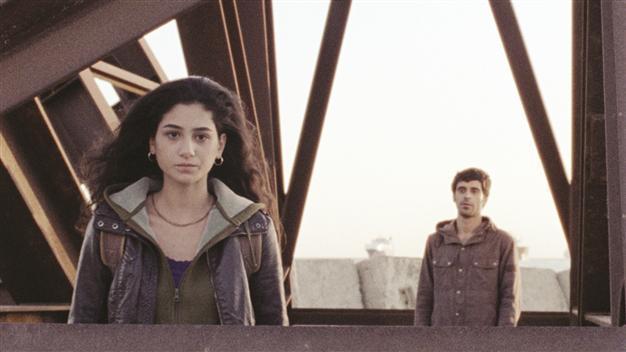‘Ferahfeza’: A film on dreams and following dreams
EMRAH GÜLER

‘We now live in an era where all ideologies have fallen apart and hope is replaced by vulnerability and fear. Ships focuses on the journey one takes while trying to realize ones’ dreams’ says Elif Refiğ.
“Have you ever noticed that we are always looking at the same direction from the same direction?” This yearning by Ali, the 20-something protagonist of Elif Refiğ’s debut feature “Ferahfeza” (Ships), to his friend Kısmet, is at the heart of the story. In the scene it is night time, and the two friends are hanging out in the shipyards where they are working during the day.At first glance, Ali (Uğur Uzunel) is your typical dreamy young man with no sense of direction. Perhaps he is too dreamy for his own good, perhaps the bleak atmosphere of the shipyards and harbors he is working in is too depressing, or perhaps working for a strict father leaves little space for dreaming. All of these make life suffocating for him.
Ali slacks off from the job he has no connection to, finding every chance to watch the ships departing from the industrial complexes that are a stark contrast to the sea next to them. The shipyards and harbors are on the outskirts of Istanbul, but far removed from the exotic connotations of the city. His only escape is dreaming, watching for signs on and off sea that will lead him to a better life, but how much better he has no clue.
Across the sea, Ali is looking for the ship named Vamos that he has seen in his dreams, which will somehow take him to ultimate freedom. And off sea, he notices graffiti of a ship sprawled across a wall.
Finding the graffiti artist becomes Ali’s raison d’être in a life otherwise going down in a spiral. Finding out that the artist is a young woman of his age tops off his quest to find her. At first, Eda (Sitare Akbaş) is apprehensive of this young man, whose only desire is to forge a connection and share his dreams. When Ali is able to win her confidence slowly but surely, the two embark on a journey of hope and love in a world where there is no light at the end of the tunnel for either of them.
“Ali and Eda are constantly listening to the warriors inside them,” said director, writer and producer Elif Refiğ to the Hürriyet Daily News. “The warriors inside them are both from the other sex, making the characters more layered and more interesting. The reason Ali is able to have faith, perseverance and hope, that makes him stronger, is the “feminine” inside him. Eda perceives being feminine as a threat, and opts to become stronger through embracing the “masculine” inside her. When the two characters talk to the warriors inside them, they are actually talking to the opposite sex.”
Dream a little dream of me
After graduating from Boğaziçi University in Istanbul, Elif Refiğ completed her MFA in Film at Columbia University in New York. Her feature screenplay “Adanmış Detaylar” (Devoted Details) was a finalist for the 2004 Sundance Institute Screenwriters Lab. She received the Gestures of Reconciliation Screenwriting Prize from the Goethe Institute with her second film “Esperanza Starring.”
Refiğ sites the Istanbul International Film Festival and the progressive film classes at Boğaziçi University held by Mithat Alam, and later the film center established in the university, as her introduction to cinema. Most of the names in the clique that Refiğ was part of, who watched, discussed and wrote about cinema in the university, such as Yamaç Okur, Nadir Öperli, Enis Köstepen and Fırat Yücel, are now working in the film industry or writing about films.
Going back to Ali and Eda, the bond between the two becomes all the stronger as both of them have problematic relations with their families. “Suffocating in the name of protecting is a common mistake we encounter in nuclear families,” said Refiğ. “I don’t think Ali and Eda’s families are bad per se. They just don’t know how to look and listen, and are therefore unable to understand. They are afraid of freedom both for themselves and their families.”
The shipyards and harbors form an integral part of the film, creating an atmosphere that accentuates the dream-like quality of Ali and Eda’s relation that alternates between hope and nightmares. “When I was establishing the visual language of the film, I was careful in selecting locations that would support the major thematic conflict in the film,” said Refiğ. “The Tuzla Shipyards might be situated next to the open sea, but with their nonflexible structure, the routine work flow, as well as a sense of dread and claustrophobia they inflict, their characteristics show similarities to everyday lives of Ali and Eda.”
“While being in that constricted setting, they follow a dream they are able to experience through the first-hand relationship they have with the open sea,” said Refiğ. “They pursue their dreams in a place where dreams and dreaming are frowned upon, but nevertheless it is a place that allows dreams to flourish.”
Is “Ferahfeza” a film of hope, or the opposite? “We now live in an era where all ideologies have fallen apart and hope is replaced by vulnerability and fear. Ships focuses on the journey one takes while trying to realize ones’ dreams,” said Refiğ. “The story makes the point that the journey itself is what matters by helping one grow and change, regardless of whether the dream is actually realized at the end. The story of Eda and Ali urges young people to be courageous, take challenges and have a dream.” “Ferahfeza” is a film for dreamers, indeed.
















